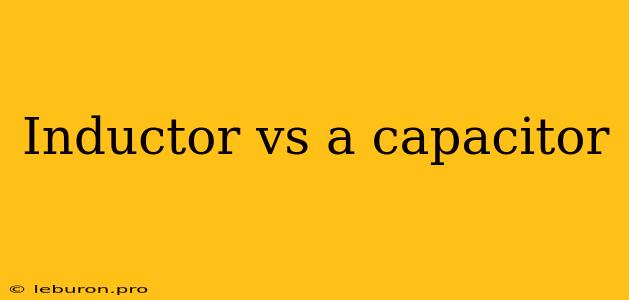Inductors and capacitors are fundamental components in electronic circuits, playing crucial roles in shaping and filtering electrical signals. While both devices store energy, they do so in fundamentally different ways, leading to distinct characteristics and applications. Understanding the differences between an inductor and a capacitor is essential for any electronics enthusiast or professional seeking to design and analyze circuits effectively. This article aims to provide a comprehensive overview of these two essential passive components, delving into their operating principles, key characteristics, and applications.
The Fundamentals: How They Store Energy
At their core, both inductors and capacitors store energy, but they do so in vastly different ways.
The Inductor: Resisting Change in Current
An inductor's ability to store energy stems from its opposition to changes in current. It consists of a coil of wire, typically wound around a core of ferromagnetic material, such as iron. When current flows through the coil, a magnetic field builds up around it. The energy stored within this magnetic field is what constitutes the inductor's stored energy.
The key characteristic of an inductor is its inductance, measured in Henrys (H). Inductance quantifies the ability of the coil to store energy in its magnetic field. A higher inductance value implies a stronger opposition to current changes.
Here's a simplified analogy: Imagine a heavy flywheel. It takes a lot of effort to get the flywheel spinning (current change), but once spinning, it stores kinetic energy (magnetic field). Similarly, an inductor resists rapid changes in current, but stores energy in its magnetic field when current flows.
The Capacitor: Resisting Change in Voltage
Capacitors, on the other hand, store energy by creating an electric field between two conductive plates separated by a non-conductive material called a dielectric. When a voltage is applied across the capacitor's plates, charge accumulates on the plates, forming an electric field. This stored electric field represents the capacitor's stored energy.
The capacitor's key characteristic is its capacitance, measured in Farads (F). Capacitance quantifies the ability of the capacitor to store charge and energy within its electric field. A higher capacitance value implies a greater ability to store charge at a given voltage.
Analogy: Consider a water tank. Filling the tank with water (charging the capacitor) requires work, but the tank stores potential energy in the form of the water's elevation. Similarly, a capacitor stores energy in its electric field by accumulating charge.
Comparing Key Characteristics
1. Energy Storage Mechanism:
- Inductor: Stores energy in a magnetic field generated by current flow through its coil.
- Capacitor: Stores energy in an electric field created by charge accumulation on its plates.
2. Opposition to Change:
- Inductor: Opposes changes in current.
- Capacitor: Opposes changes in voltage.
3. Impedance:
- Inductor: Impedance increases with increasing frequency.
- Capacitor: Impedance decreases with increasing frequency.
4. Phase Relationship:
- Inductor: Current lags behind voltage by 90 degrees.
- Capacitor: Current leads voltage by 90 degrees.
5. Applications:
- Inductor: Used in filters, transformers, energy storage circuits, and radio frequency (RF) applications.
- Capacitor: Used in filters, power supplies, timing circuits, and energy storage circuits.
Applications of Inductors and Capacitors
Both inductors and capacitors find widespread use in various electronic circuits and systems.
Inductors in Action:
- Filters: Inductors are often used in conjunction with capacitors to create low-pass, high-pass, band-pass, and band-stop filters. These filters selectively allow or block certain frequency ranges, which is crucial for signal processing and noise reduction.
- Transformers: Inductors form the core of transformers, devices that use electromagnetic induction to change AC voltage levels. They are indispensable for power distribution, electrical isolation, and impedance matching.
- Energy Storage: Inductors can store energy in their magnetic fields, making them useful in power supplies and energy harvesting applications. They can release this stored energy rapidly, providing a short burst of power.
- RF Circuits: Inductors are essential components in high-frequency circuits, such as radio frequency (RF) oscillators, amplifiers, and antennas. They are used to tune resonant circuits and control the flow of high-frequency signals.
Capacitors in Action:
- Filters: Capacitors are used in filters alongside inductors or resistors to shape the frequency response of a circuit.
- Power Supplies: Capacitors are used in power supplies to smooth out the ripple voltage from rectifiers, ensuring a stable DC output.
- Timing Circuits: Capacitors, in conjunction with resistors, can be used to create RC time constants, which form the basis for timers, oscillators, and delay circuits.
- Energy Storage: Capacitors can store significant amounts of energy, making them suitable for applications such as backup power supplies and electric vehicles.
Conclusion
Understanding the fundamental differences between inductors and capacitors is crucial for designing and analyzing electronic circuits effectively. Both components are essential building blocks in electronics, enabling a wide range of functionalities and applications. While they store energy in distinct ways, they complement each other in various circuit configurations, allowing for sophisticated filtering, signal processing, and power management. Their unique characteristics and applications make them indispensable components in a diverse range of electronic devices and systems.
